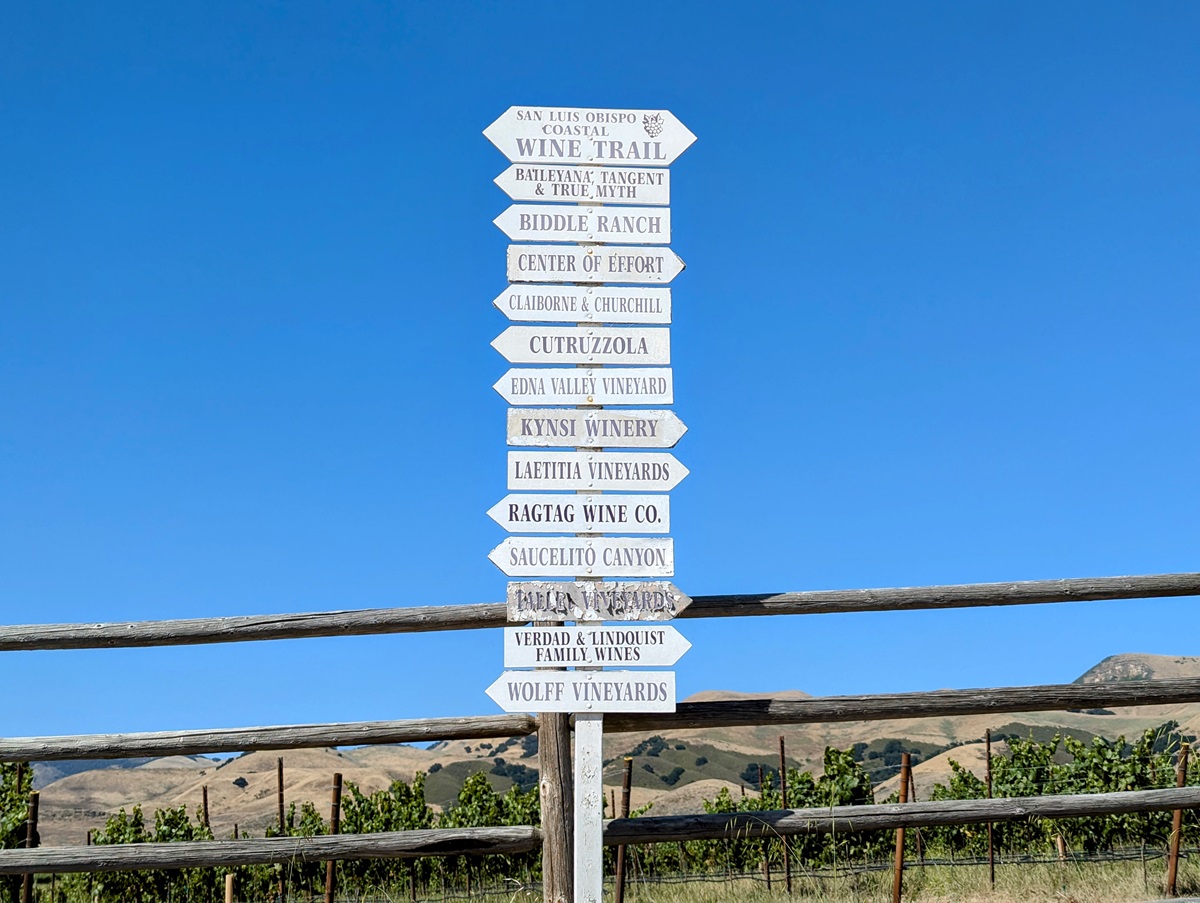Edna Valley wine country is compact, with 13 of about 30 total wineries within a few miles of downtown San Luis Obispo. Image courtesy Craig Stoltz.
It was June of 2024, and I could feel the momentum of Edna Valley wine country, located about halfway between L.A. and San Francisco. I was sitting on the tasting patio overlooking the vines of The Language of Yes winery. There, in the shadow of a voluminous contemporary tasting room that could easily have been plucked from a Napa hillside, my wife and I were tasting the utterly novel, skillfully crafted wines created by Rhone-style visionary Randall Grahm, like his nearly ethereal red made from Cinsault grapes air-dried for three weeks before fermentation.

This lovely piece of ground is precisely where Jack Niven, the founding father of Edna Valley winemaking, established his operation in 1973. The Niven family sold this part of their holdings to E&J Gallo Winery in 2011. By 2023, that global wine colossus had established this avant-garde project here — demonstrating a clear interest in the future of winemaking in this long-overlooked slice of California wine country.
And by July it had been sold to yet another winery, yet unnamed.
Clearly, little Edna Valley is in motion — catching the eyes, the talent, and the money of California winemaking.

The Edna Valley AVA, established in 1982, is about five miles from the Pacific Ocean, whose breezes ease through mountain gaps and create a terroir perfect for cool-climate grapes like Chardonnay and Pinot Noir, adaptable Rhones like Grenache and Syrah, and some less common varietals like Albariño, Viognier, and Grüner Veltliner.
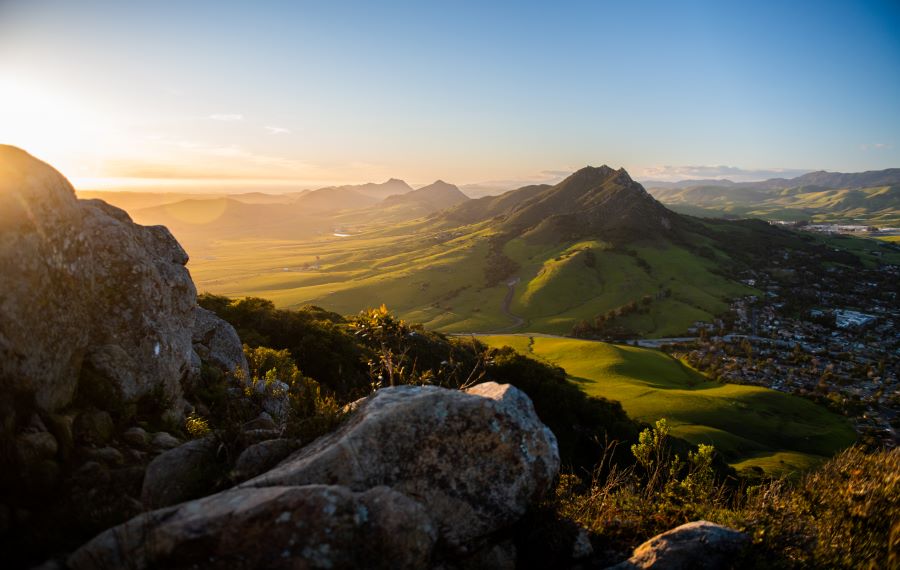
You could strike Edna Valley wine country from the hills above San Luis Obispo, a charming historic town thrumming with the energy of California Polytechnic State University, with a powerful shot from a trebuchet. And the vineyards are just 15 minutes from some lovely beach communities. So unlike nearby Paso Robles, that hoppin’ central coast destination focused exclusively around wine, Edna Valley presents a traveler with a long weekend or happy week offering eclectic pleasures: the food and frolic of a lively small city, a day at the beach, and visits to any of dozens of wineries ranging from 40-year-old outfits run by self-taught vintners to some enterprises near the forefront of California winemaking.
Plan a visit today, and ten years from now…who knows? You may be able to brag to your friends about how you went to Edna Valley before it was the next big thing.
Getting to Edna Valley
San Luis Obispo — if you’re trying to impress locals, call it “SLO” or, better, “slow” — has a small airport served by American, United, and Alaska Airlines. Direct flights come from San Francisco, L.A., Portland, Seattle, Phoenix, Denver, Dallas, and Las Vegas.
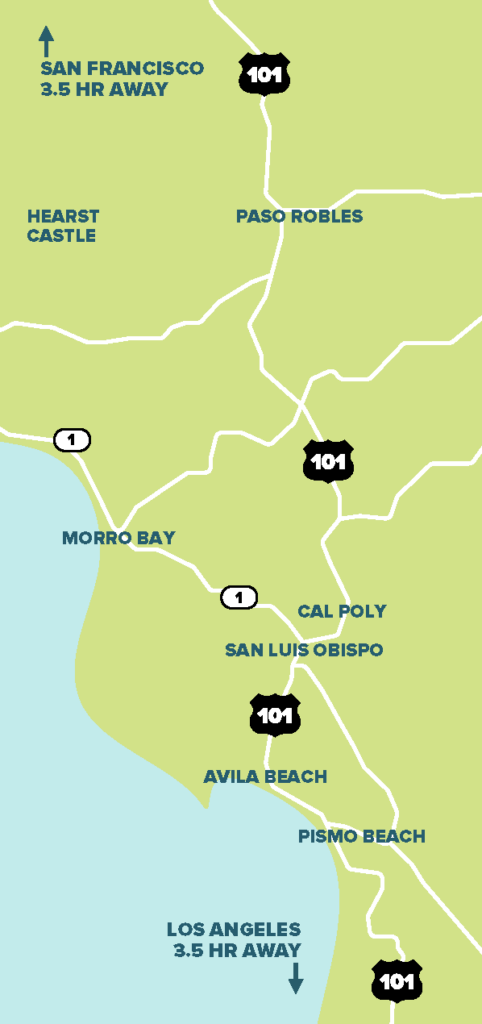
Alternatively, and more affordably, you can fly into Los Angeles and rent a car. It’s a sometimes-scenic three-hour ride up the 101. You can stop over in Santa Barbara County, that famed land of vineyards that the movie Sideways put on the wine travel map 20 years ago. Unfortunately, the Pacific Coast Highway tracks inland in that part of California, so you can’t wind your way along the ocean to SLO.
If you’re coming from San Francisco it’s a three-hour straight shot south, but you can indeed curl down the Pacific Coast Highway part of the way (check for closures).
Or if you’re feeling up for the picturesque shake-and-rattle, Amtrak’s Surfliner runs between Oakland and San Diego with a stop in SLO.
In any case, you’ll need a car. Unlike places like Napa and Sonoma, there are no organized wine tours to get you around. Like I said, Edna Valley’s still in the shadows. For now.
RELATED: These Are Some of the Top Wineries to Visit in Napa Valley This Year
Edna Valley Terroir
Most Edna Valley vineyards are planted on gently rolling terrain, and from practically any location you can spot what locals call the “Nine Sisters” (or the “Morros”), a chain of volcanic plugs that both attract outdoor enthusiasts and contribute to the area’s diverse, productive farmland. The sea covered the area millions of years ago, producing a marine layer; the volcanic stubs contributed magma and ash, and have been eroding into the surrounding landscape for over 20 million years. Today the composition of the land can vary by plot and hillock, comprising any combination of marine fossils, porous stone, sand, and rich humus, loam, and clay.
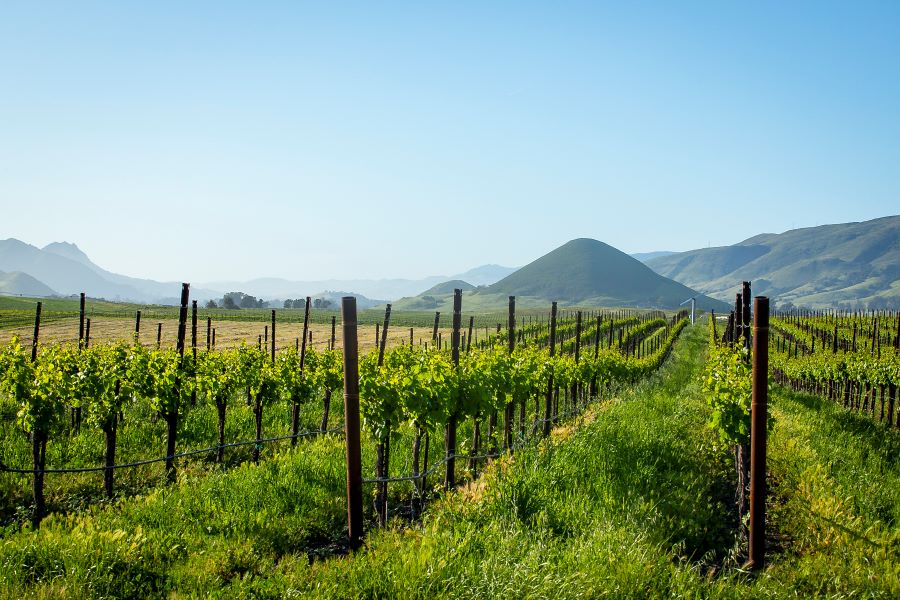
The ocean brings not only cool temperatures but clouds, which roll in most mornings and slide off in the evenings, meaning sunshine and diurnal variation are more moderate than they are in, say, Paso Robles. But the growing season in Edna Valley is one of the longest in California, allowing slow ripening and a later harvest, producing grapes from which the right hands can coax more complex, nuanced flavors.
The AVA is about 35 square miles, and about 1,500 acres are planted with grapes. (For context, Paso Robles has about 40,000 acres under vines, Napa about 45,000.)
Neighboring AVAs
Things can get a bit complicated as you start to navigate wine country in the nearby parts of the Central Coast. The Edna Valley AVA is tucked within the sprawling San Luis Obispo Coast AVA (recognized only in 2022), a cool-weather zone that reaches from Monterey in the north to Santa Barbara County in the south. Edna Valley AVA shares borders with the Arroyo Grande Valley AVA to the south. And just a few miles inland, to the east and north, is the commanding Paso Robles AVA.
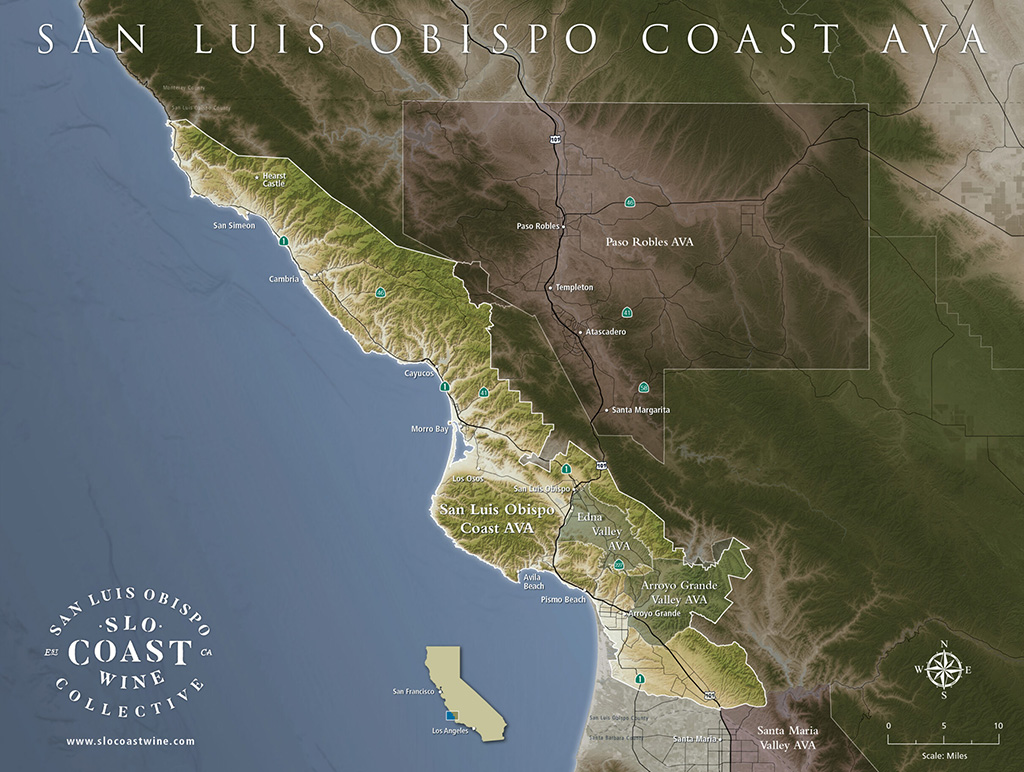
That’s a lot of distinctive terroirs within a fairly small range. Which is to say: You have many good reasons for multiple visits to this lovely expanse of California, so full of natural beauty, worthy attractions, and diverse wines.
The History of Edna Valley Wine
In the early 1970s, former grocer Jack Niven and restaurateur Norm Goss sought the advice of viticulture experts at UC Davis and Fresno State to determine where to buy farmland to grow grapes and which varieties to grow. In 1973 the Nivens planted the original 547 acres of Paragon Vineyards, and in the same year, Goss established Chamisal Vineyard on 80 acres nearby. They mostly grew Chardonnay and Pinot Noir. They sold their grapes to others.
In 1980 the Nivens created Edna Valley Vineyard and Winery and started making wines themselves, and Goss did the same at Chamisal. Jack Niven became the driving force behind getting Edna Valley its American Viticultural Area designation, the first in San Luis Obispo County and only the 10th in the United States.
The wines built a reputation pretty quickly. The Nivens’ Chardonnays were regularly served at the White House during the Reagan Administration. In a 1982 blind tasting hosted by Steve Spurrier — the same guy who put together the famed 1976 Judgment of Paris blind tasting, which resulted in American wines gaining parity with their French counterparts — the Nivens’ Paragon Chardonnay tied for first place with a Napa one. Chamisal’s 1986 Chardonnay scored 91 from Wine Spectator, a peak for Edna Valley wines at the time.
It wasn’t long before Niven Family Wine Estates had expanded to include five labels, Chamisal had been sold to an ambitious tech executive, and dozens of wineries were in operation around SLO, ranging from small, family-run operations like Kynsi, begun by an engineer-turned-self-taught-winemaker, to outfits like Corbett Canyon, which made bulk wines advertised on TV. Some of the winemakers diversified into more obscure varietals.
A few Edna Valley operators established environmentally sound practices, putting the valley on the early map for sustainable winemaking, a position it continues to occupy today. Valley winemakers were among the prime movers behind creation of the SIP (Sustainability in Practice) designation, the nation’s most rigorous certification of sustainable and ethical winemaking practices. It was launched from the Central Coast and is now adopted by dozens of wineries across California and the American West.
Management of the Niven family business eventually transitioned to the second and third generations, and, well, you know how that can go.
In 2011, the Niven family sold their share of Edna Valley Vineyard to E&J Gallo Winery but retained ownership of their other wine operations. Until 2020, that is, when they sold their four wine labels and tasting room to WX Brands, a company with an international portfolio of wines. Other holdings are now farmed by Paso’s estimable Daou, which makes a $70 Eden Valley Pinot Noir (and Daou itself has recently been bought, by the Australian Treasury Wine Estates, for a reported $1 billion). Chamisal was purchased by a Napa-based brand owner. A former CEO of Raytheon bought another one of Edna Valley’s pioneering winemakers and has given it the Full Napa treatment.



Edna Valley historic transformation sites: The Jack Niven Hospitality Center, owned by E&J Gallo Winery, pays tribute to Edna Valley’s pioneering winemaker; Chamisal, another early area vintner, is part of Napa-based Crimson Wine Group; today Center of Effort, owned by a former corporate CEO, operates in the space once occupied by Corbett Canyon, Edna Valley’s first mass-market winemaker. Images courtesy Craig Stoltz.
In other words, money’s moving in, things are in flux, and everybody seems to be waiting to see what Edna Valley’s next chapter holds.
An Edna Valley Wine Tour
Edna Valley wine country is very approachable, offering about 30 wineries, most within a 20-minute drive of downtown San Luis Obispo. I’ve selected six that take you from the O.G.s of the valley to the latest high-spending entrants doing the most extravagant vinting in the region. (I had to omit the Language of Yes at Edna Valley Vineyards, now closed. Its successor had not been named by the time this story went live.)
Note that not many wineries in Edna Valley offer food or entertainment, though some bring in food trucks and music once a week. (Bocce seems to be a thing.) While a few places offer charcuterie or even more extravagant food, as noted below, for the most part you should expect unadorned tastings.
Most wineries open at 11 a.m. and close at 5 p.m. A good plan might be to hit one or two visits before lunch, head back to SLO for a midday meal, and then make one or two more visits in the afternoon. There are some fantastic restaurants with excellent wine lists in SLO, so your wine and food adventures can continue well into the night. Recommendations for wine, food, and lodging in SLO appear below.
As with all self-guided wine tours, it’s best to make reservations or at least call ahead to make sure a drop-by within a certain time window will work. That will also give you a chance to find out if any food, activities, or tours are available. Some of these places are small enough where you could wind up with unexpected face time with the winemaker.
Baileyana Winery
5828 Orcutt Road, San Luis Obispo
I recommend you make this roadside tasting room, a converted 1909 schoolhouse, your first stop. It’s the outpost of the wine operations of the Niven family, the pioneers of Edna Valley wine. (It’s all owned by WX Brands, but the original team and vibe remain in place.) The Baileyana labels draw heavily from the family’s longtime vines, but they also source from Paso Robles and the San Luis Obispo Valley AVA to diversify their offerings.
Baileyana comprises four brands: Baileyana, Tangent, True Myth, and Zocker. The wines reflect the nuance and balance that come from working the same land and varietals for 40 years — and of winemaker Rob Takigawa, who has been hands-on with the wines for 20 of them. There wasn’t a clinker in the bunch.
Our tasting included four Baileyana offerings, including a “Halcon Rojo” Pinot that had lovely, light cherry tones. Another standout was the S-BAR Chardonnay, harvested from select blocks and rows. While it was barreled in French oak the fruit came through beautifully, all pears and lemons with small background notes of vanilla. It was the most expensive bottle in the tasting at $45.
There was also a Tangent “Clone 530” Sauvignon Blanc, geekily named after its Loire cutting, and a red blend under the True Myth label, a mix of 50 percent Cab, 42 percent Syra, and 8 percent Tempranillo. Sadly there was nothing else on offer from its Tangent bottlings, a screwcap line of Albarinos, Pinot Gris, and one aggressive blend of six whites it calls Ecclestone. Forty years on, the Nevinists are still going places, even if they are no longer the owners.
During your visit, expect little more than the wine. There’s a bocce court and a beautiful view of the vineyards.
Center of Effort
2190 Corbett Canyon Road, Arroyo Grande
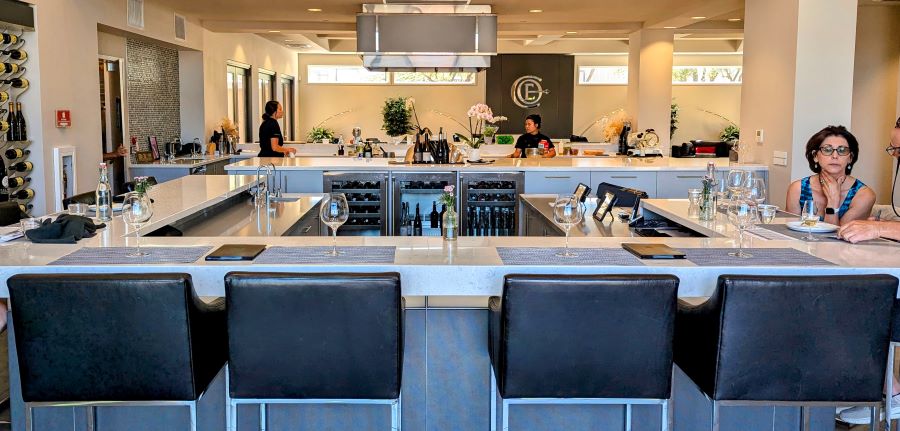
No matter how jaded you are from your visits to extravagant modern temples of wine, prepare to mutter “Wow” when you approach the Center of Effort in humble Edna Valley.
The vision of former Raytheon Company CEO (and Cal Poly graduate) Bill Swanson and his wife Cheryl, the Center of Effort campus includes an expansive contemporary visitors center and tasting room backed by a kitchen whose design alone is worth a Michelin star, a broad patio and lush lawn overlooking vines of Pinot, Chardonnay, and GSM varietals, an orchard, a putting green, an oyster-shell bocce court, and a pristine wine production facility. It’s set up not just for tastings but for corporate hospitality, and way off in the back somewhere is the place they make bulk wines for clients they won’t name (Swanson clearly didn’t lose his business chops when he retired).

I strongly recommend going for the $65 per person tour and tasting, which includes paired small plates. It was the tasting highlight of our trip. Unlike some wineries, Center of Effort brings out the good stuff: Everything we tasted had earned at least a 93 from Wine Enthusiast, and three of the five were priced at $60 per bottle.
The wines were beautiful. There was a GSM estate Rosé fermented in concrete; the fruit seemed to float from the surface of the glass. By contrast the Arrivo 2020 Pinot Noir, which spent 19 months in half-new French oak, was of the deeply “masculine” variety, and very smooth — like forest wrapped in a silk sachet. Winemaker Kevin Bargetto, a Cal Poly grad who got a lot of his wine training in Australia and New Zealand, is clearly on his game.
Each wine was skillfully paired with a dish of meticulous, creative tweezer food nearly worth the $65 tab by itself. And the tour of the impressively clean and efficient winemaking facility includes a visit to see the concrete “eggs” where some of the most creative vinting takes place. (We learned from the guide that “center of effort” is a sailing term referring to a point on a sail where all the forces come together and act as one).
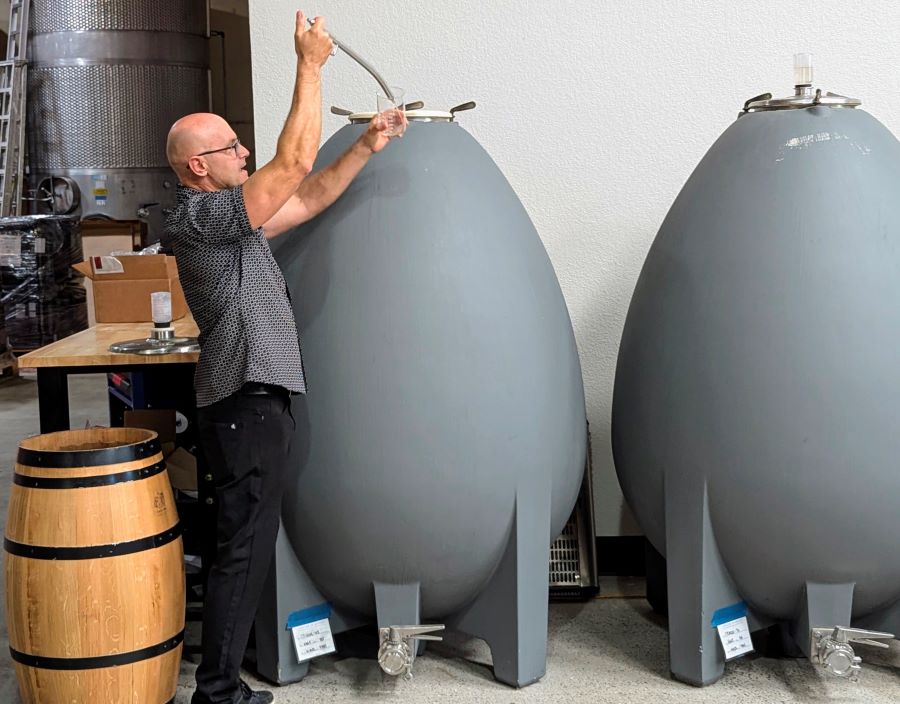
In a way, Center of Effort tells the entire Edna Valley wine story. The property was originally farmed by Jim Lawrence, one of the first to see the potential of the area. But he soon sold the operation to Corbett Canyon, maker of the sort of wine displayed at knee level at the liquor store. And now Center of Effort has become a standard-bearer for Edna Valley’s next chapter of premium winemaking, even as it produces volume products in the background.
Reservations are absolutely necessary. Build your trip around this one visit if you must.
Kynsi Winery & Vineyard
2212 Corbett Canyon Road, Arroyo Grande
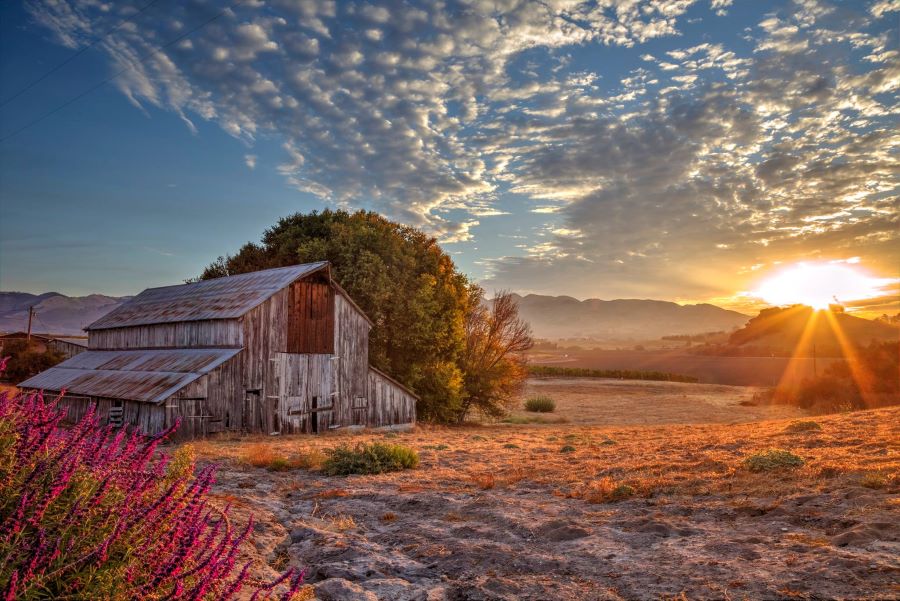
For a taste of way back Edna Valley, pull in at Kynsi. The vintage tractor by the entrance sets the mood.
Don Othman, trained as an engineer, invented a piece of equipment in 1986 called the Bulldog Pup, a device useful in transferring wine (but particularly delicate Pinot Noir) from one vessel to another to remove sediment, a process known as racking. It’s been widely adopted in the industry.
Since he’d spent a lot of time with winemakers observing their techniques, in 1995 Othman followed the path of many hopeful and inspired amateurs and founded Kynsi (the word for a barn owl’s talon). He was joined in the business by his wife, and now a daughter and son-in-law.
Tastings are hosted in an old ranch building adjacent to a defunct dairy barn, and everything is kept very simple.
Pinot Noir has been the operation’s focus, but our $25 tasting also featured a fun Harvest Cuvee, described as “built for barbeque,” blending 75 percent Pinot and 25 percent Syrah. A playfully fruity ‘21 Grenache Jespersen Vineyard is sourced from one of the coolest-temperature parcels in the AVA.
A 2020 Syrah Kalanna, dry and rich with dark fruit, is the project of the Othman’s two daughters, Kala and Anna.
The Language of Yes
2585 Biddle Ranch Rd., San Luis Obispo
This distinctly odd name — it’s a translation of “Languedoc,” the center of Rhone winemaking — is a project of Randall Grahm, an eccentric, legendary master of creative Rhone blends in California. (Wine Spectator once made him their cover boy as “The Rhone Ranger,” and the nickname stuck.) When we visited, the conversion of the massy, glassy Jack Niven Hospitality Center into the Language of Yes tasting room was about six months old.
The service and presentation are worthy of the elevated product. Glasses are suspended on elegant tabletop wire loops. A grassy slope overlooks the vines. The only disturbance is the occasional widebody aircraft roaring overhead as it eases into the SLO airport, the price of the region’s progress.
The tasting notes provided are both precious and precise. About the 2023 Les Fruits Rouge, a blend of Cinsault, Grenache, Syrah, and Tibouren, this is said: “With varietals native to southern France this wine offers mimetic notes of the red stone fruits that are often grown nearby.” (I had to look up “mimetic.” It means mimicry.)
The 2022 “Le Cerisier” Pink Wine (not a Rosé, please), a blend of Tibouren, Cinsault, and Grenache: a “voluble fragrance” is “jumping out of the glass,” with a “creamy” result.
I don’t know about all that, but all the wines struck me as unusual, even arresting. The challenge was to find a reference point for them. When you taste a Pinot or a Sauvignon Blanc or a GSM blend you know approximately what to expect and you look for details, differentiation, surprises. Each of these wines seems to speak a delightful foreign language you’ve never heard before. The language of yes, one is tempted to say.
Biddle Ranch
2050 Biddle Ranch Road, San Luis Obispo

A project of four area families who literally bought the ranch, Biddle is a small operation — 17 acres of vines, a pleasant shaded tasting patio, and a 3,100-square-foot Vineyard House it rents out for overnight stays or events. (It’s Edna Valley’s only on-vineyard overnight accommodation.)
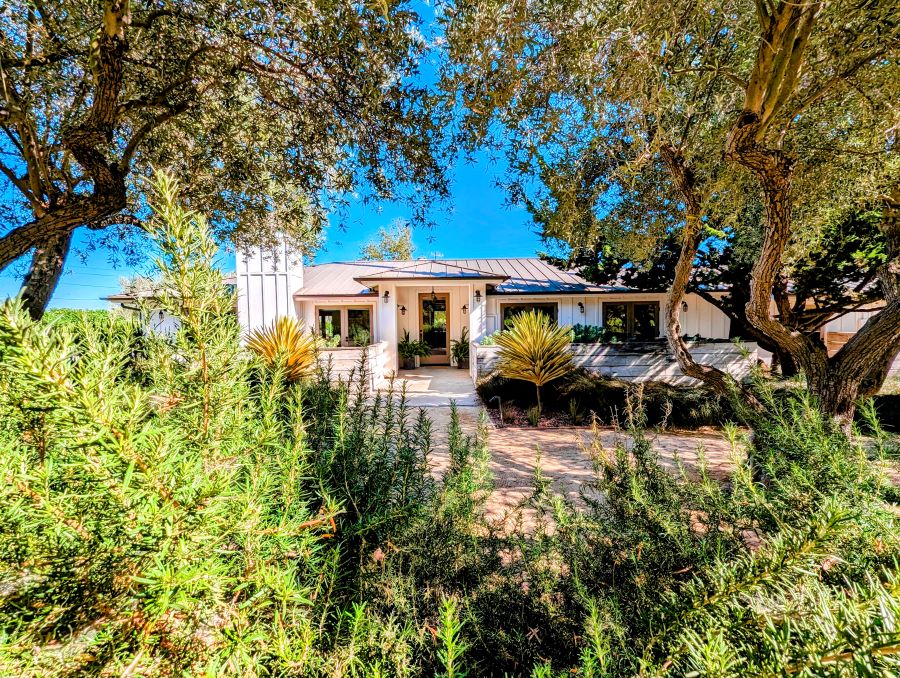
The wines are made by Ryan Deovlet, a Central Coast up-and-comer. Our tasting included a pleasant estate Chardonnay and a lovely SLO Coast AVA Rosé of 60 percent Pinot Noir and 40 percent Syrah.
The 2020 Cab, sourced from Paso Robles’ Denner Vineyard, was a monster of fruit, acid, and tannin. A few more years in the bottle and it’ll make a great glassful next to your ribeye.
Chamisal Vineyards
7765 Orcutt Road, San Luis Obispo
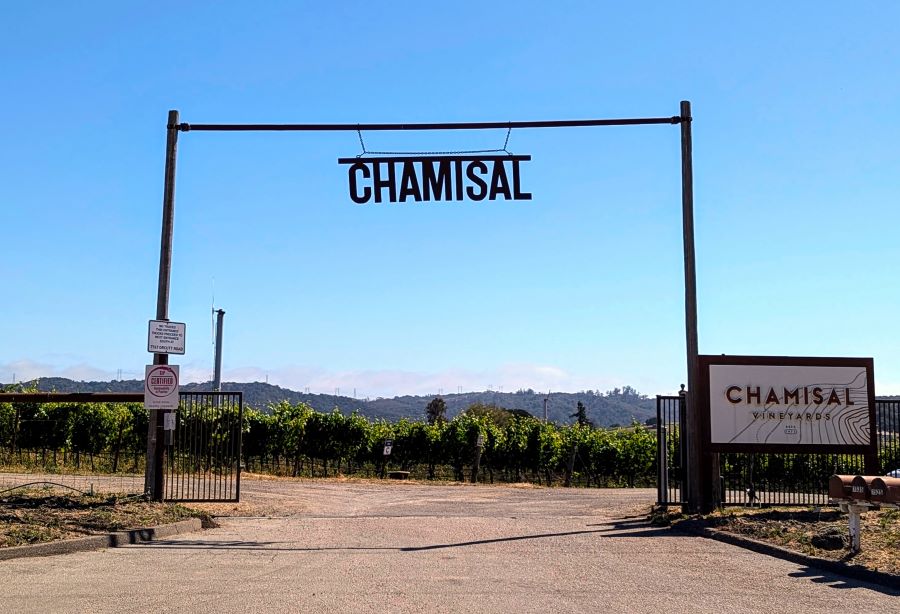
Just 10 miles from SLO, this property was among the first to be planted in Edna Valley, in 1973, and its 82-acre estate vineyard is beautiful and mature.
In recent years it’s come to focus more on Chardonnay, and the one that blew me away was the 2022 SLO Estate Coast Chardonnay, with sharp aromas of apple, a marked acidic bite, and a lovely throughline of minerality. The Malene Estate Grenache Rosé was the best we tasted in Edna Valley.
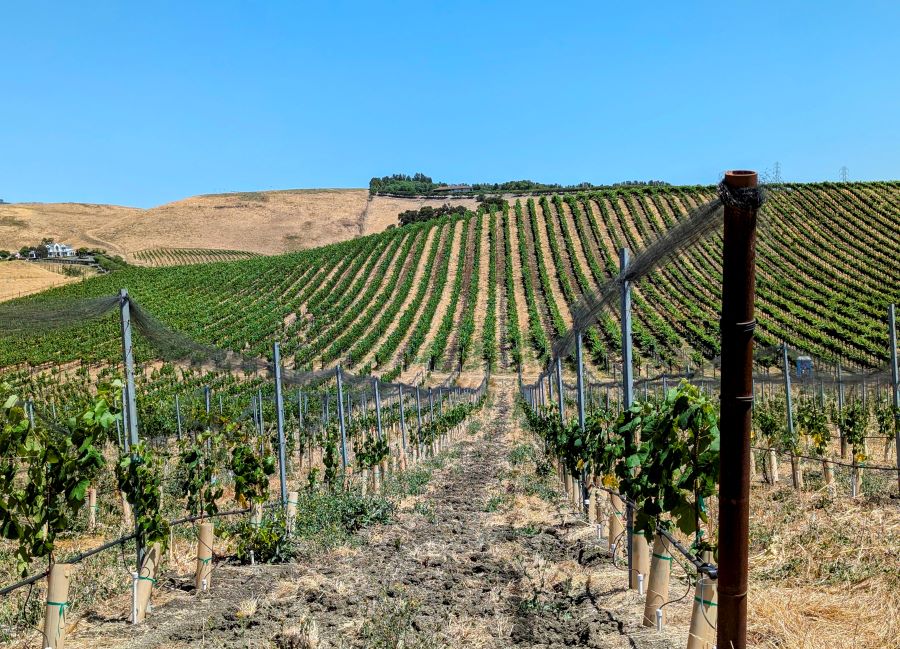
The wines are the work of winemaker Brianne Engles, another Cal Poly grad. She has trained in Paso, Napa, and Australia, and brings a geeky eye for detail in terroir and winemaking to her efforts. She earnestly discusses the three kinds of loam on the property, and describes how the micro-climate just beyond the swale over there affects the flavor of the grapes. The vineyard is rimmed by a mountainscape that’s luminous in the late afternoon.
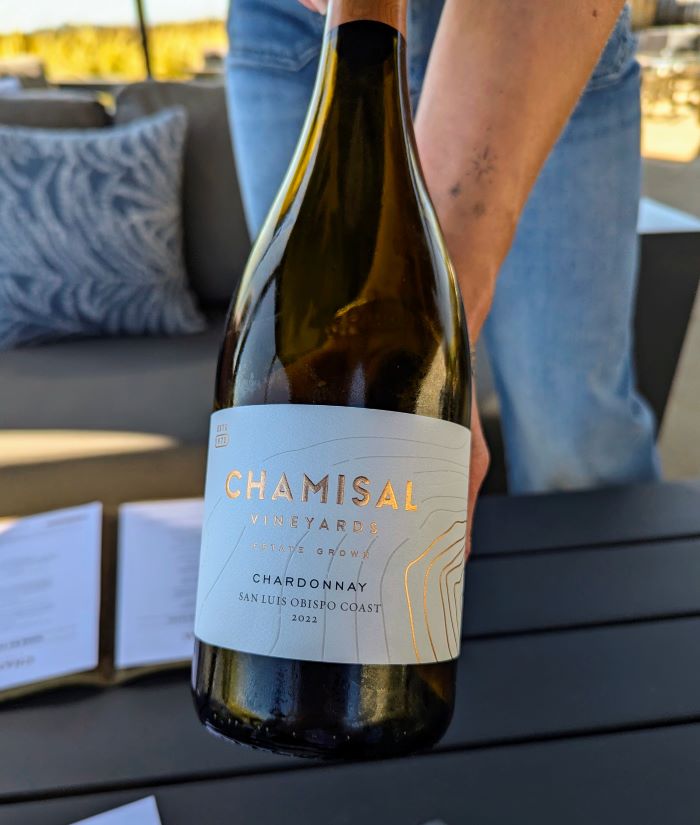
All this and a great environmental record: Chamisal was one of the first wineries to achieve Sustainability in Practice status, and it generates a quarter of its power from rooftop solar. It brings in sheep to control weeds, and is adopting some biodynamic practices.
It hasn’t been a straight line to success for Chamisal. The property went into decline under its founders in the late ‘80s and was revived in the ‘90s by Silicon Valley silicon chip man Terry Speizer, who renamed it Domaine Alfred, invested heavily, and built it into a premier Central Coast Pinot house. In 2008 he sold to Napa’s Crimson Wine Group, which owns five other boutique brands on the West Coast. The name Chamisal has been restored, and the historic Edna Valley operation is at the forefront of area winemaking again.
Chamisal has a gorgeous property, and it has one of the more developed food and events programs of the places we visited. The charcuterie is a knockout.
Wolff Vineyards
6238 Orcutt Road, San Luis Obispo
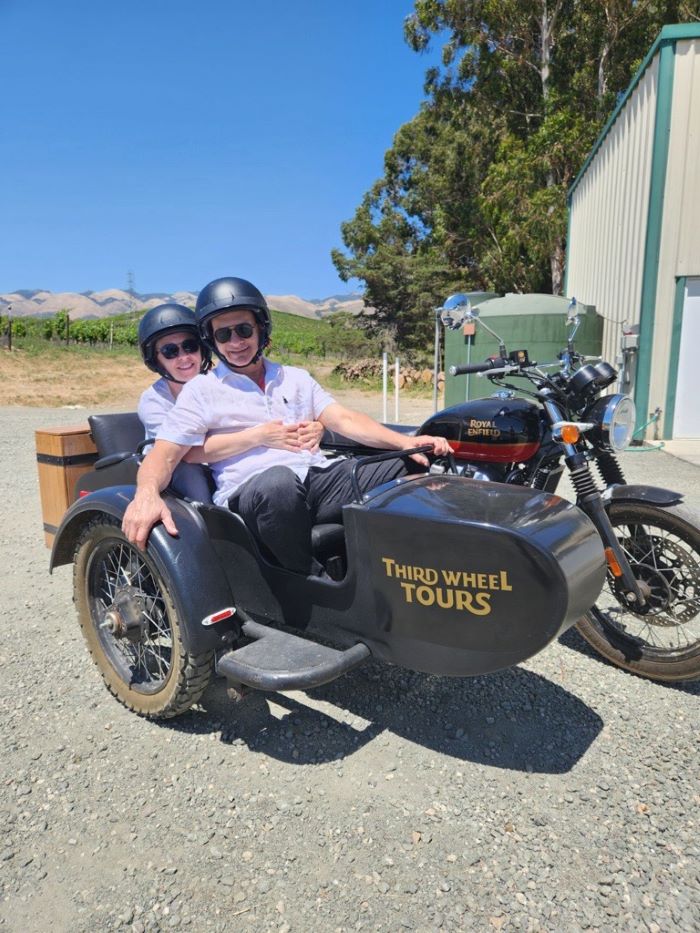
There are many notable things about Wolff Vineyards, but one of the most important is that you can take in its 125-acre property via motorcycle sidecar. My wife and I had the pleasure of getting a tour provided by a large, deeply tanned fellow with a gray fu manchu. The two of us were in the sidecar, me in front, she behind. Our guide stopped to point out features like the ingenious forms of drip irrigation, owl boxes, varietal plantings, and … well, I’m not sure about the rest, because I wasn’t taking notes and it was a wild hoot.
(It appears vineyard tours by motorcycle sidecar are a thing only in the Central Coast, mainly in Edna Valley and Paso. Who knew?)
Anyway, back in the tasting room I said hello to Jean-Pierre Wolff, one of the most through-and-through geeks of the wine world I’ve had the pleasure to meet. And I mean that in the most flattering way.
He has a degree in engineering, an MBA, and a PhD. He’s done nuclear research and taught at universities. He told me he wound up doing the wine thing in San Luis Obispo because he applied a “decision matrix” to the problem, accounting for things like price of land vs cost of grapes per ton, distance from a university where he could teach, a cool-weather terroir, and so forth. All signs pointed to the then-55-acre, 1976-vintage winery 10 minutes from SLO and Cal Poly that he bought in 1999 and has since expanded and built his artisanal winery upon.
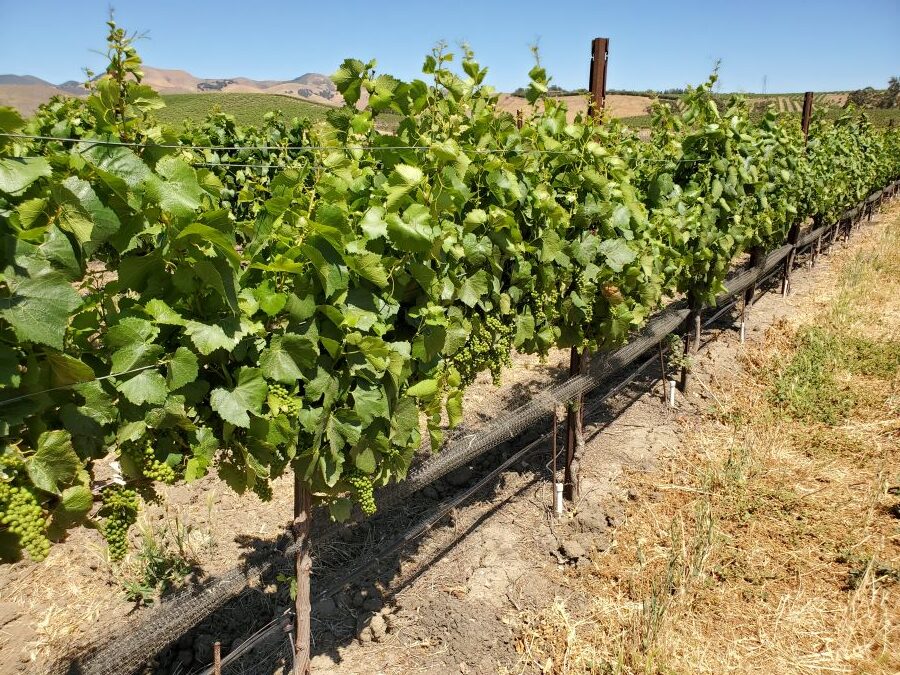
The geekery has continued: He has installed thousands of sensors along the length of his vines’ roots, and as needed irrigates underground, using half as much water as the standard above-ground drip method.
He practices dry farming on his old-vine Chardonnay rows. Half his property is conserved for wildlife habitat and livestock, which do some weeding. He was on the advisory committee during the creation of the Sustainability in Practice designation. In an experiment he’s conducting with the University of California, drones buzz his vineyards and release beneficial insects that eat mealybugs infecting his vines.
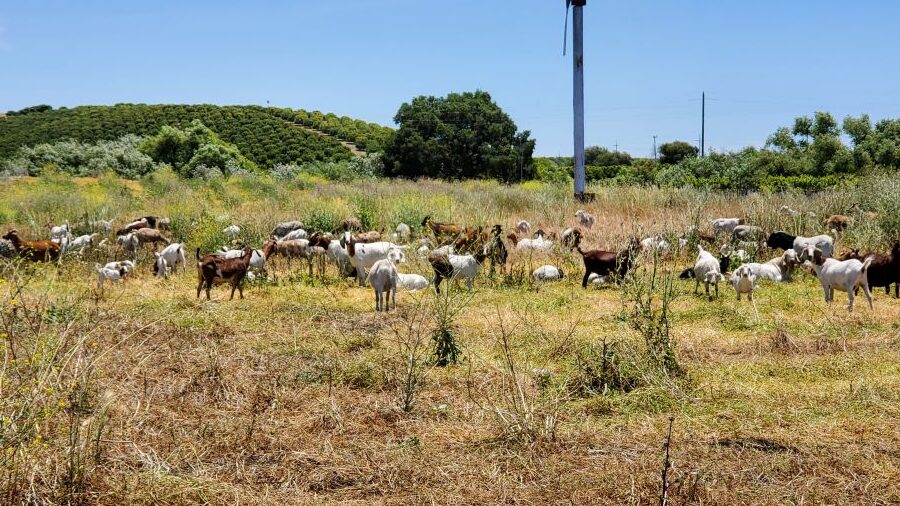
The wine itself is small production; he sells a lot of his grapes to others. Wolff draws on his European heritage and grows some varieties less common in the valley, like Rieslings. But he also sources grapes from elsewhere on the Central Coast to offer more common varietals, like his Cabernet Sauvignon.
I tried a lovely Alsatian-style Riesling, bone-dry and high with fruit. The estate Chardonnay, unlike many others in Edna Valley I tasted that apply finicky New World tweaks to the grape, was a straight-on Burgundian, its grapes from 45-year-old vines, its methods strictly traditional. It was rich with fruit and toned with oak.
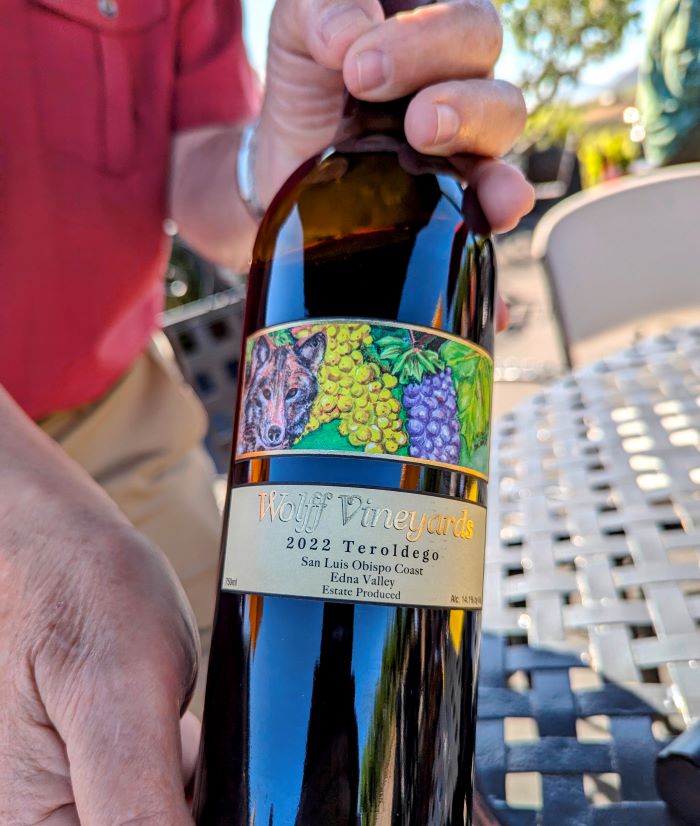
I also had a grape entirely new to me, and probably to anyone who tries it: a Teroldego, a red rarely seen in the U.S., primarily grown in a part of Italy so far North a lot of the people there speak German. It was one of the inkiest beverages I’ve ever seen, full of dark fruit, and spicy like a Zinfandel.
Wolff also grows Petite Sirah — also rare in these parts, as it’s usually a warm-weather grape more likely to be grown in climates like Paso Robles’. But he got it to work down here and others in the area now come to him for the grapes.
I told Wolff it appeared he’d managed to see around a few corners in his long wine career, and asked him what he saw coming next. He didn’t pause.
“I know everybody’s saying silly things about it, but it’s AI,” he said. “See this tablet?” he asked, grabbing a small iPad. “We get so much data — wind speed, humidity, temperature, soil temperature, moisture…it’s too much to track.” But computers are getting smart enough to digest it all and tell growers when to water, cover, and crush, or even automate those processes. “It could really be neat,” he said with a geeky smile.
Wouldn’t it be cool if the Next Big Thing in winemaking came from right here in Edna Valley?
Staying in San Luis Obispo
Any visit to Edna Valley is inevitably a visit to San Luis Obispo, and that’s a very good thing.

The old town, the location of one of California’s many 18th-century Spanish Missions, was once the core of an agricultural community. It’s matured into an eclectic small city, notable for its well-preserved 19th-century architecture repurposed for 21st-century urban play, a sophisticated ecosystem of farm-to-table restaurants, the energy and economic dynamism of Cal Poly’s students, faculty, and spin-offs, its nearby access to two fine beach communities just twenty minutes away, and of course its close connection to a slice of California wine country.
Outdoor enthusiasts love its “Nine Sisters” or “Morros,” volcanic stubs that provide plenty of hiking, biking, and climbing opportunities.
A word about parking: Downtown, it’s a bear. Street spaces are at a premium. There’s a hectic central parking garage with horrifying geometry and blind sightlines that I’m still having bad dreams about. If you stay in a downtown hotel with easy in-and-out access to your car, your visit will be a happy one. If you stay farther afield, driving out on your wine adventures will be a breeze, but you may want to count on Ubering downtown to avoid parking grief.
Hotels in San Luis Obispo
As a home base for your wine visit, I can’t recommend strongly enough a boutique hotel called Petit Soleil. Think of it as a small European hotel, but with enough electrical outlets.
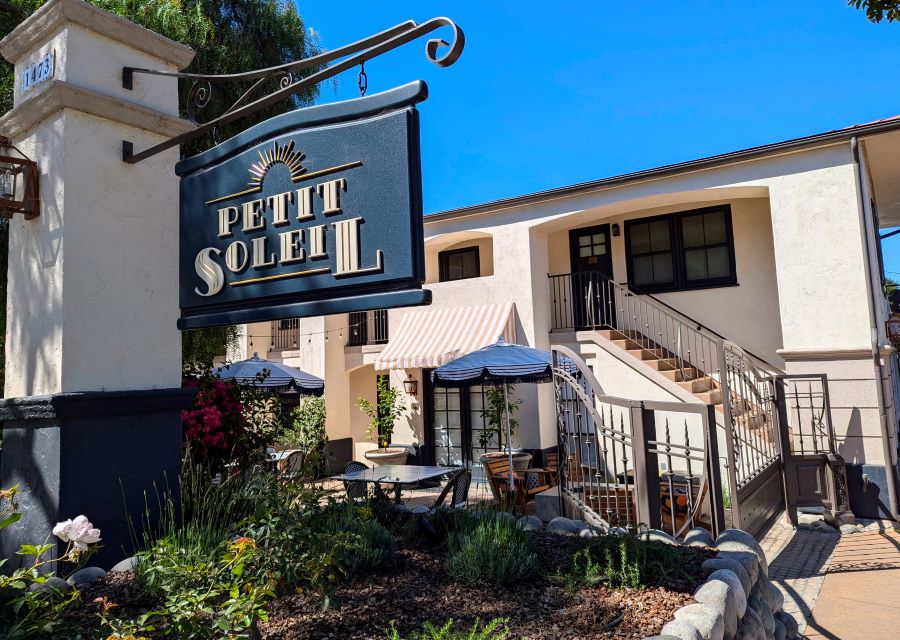
Our room was tidy and bright and full of lovable Parisian touches like lively patterned wallpaper, fabrics with touch-me textures, snazzy lighting, and a cleverly curated minibar. Located a 10-minute walk from the pleasures of downtown, the hotel offers 17 rooms arranged around a small courtyard.
It bills itself as a “bed, breakfast, and beverage,” to play off SLO’s wine connections, and it hosts a free happy hour daily with selected pours, aperitifs, and small bites. A delightful French-style breakfast is included, offering sweet or savory options. Service is efficient and on-point — and friendlier than you’ll get in France too. Parking is free and easy.
As for other overnight options, here are two places we didn’t stay but come highly recommended by locals. They’re both right in the downtown core. Check on parking policies, just sayin’.
- Granada Hotel & Bistro: Built in 1922 and renovated in 2012, this luxury (Italian linens; seersucker robes) property offers 17 rooms, a full-service restaurant, and a popular nightcap bar.
- Garden Street Inn: This Kirkwood Collection property is an airy and bright boutique bed and breakfast.
Eating in SLO
The restaurant scene in SLO is hearty, thanks to a steady clientele from the Cal Poly professoriat, wine country tourists, and a lot of young, creative minds in the agriculture and hospitality businesses. I can recommend four restaurants enthusiastically and one with an enthusiastic asterisk.
Lure Fish House
This big modern seafood place on a busy downtown corner is a new entrant to the SLO dining scene, and it was on its game during our visit. The server knew that the local Morro Bay oysters weren’t available that day, on account of an unfortunate sewage incident (don’t ask). But the point is she knew, she reported it to us, and she skillfully pointed us to alternative bivalves we’d like just as well. And we did. Nearly all the seafood served is hyper-local, and there are daily off-the-boat specials. The spicy ceviche, which includes Pacific rockfish, was silky and bright, and the black cod was excellent. The wine list has good Edna Valley representation — including Tolosa, a winery of excellent reputation I sadly didn’t get a chance to visit but got to sample at Lure. The website has a handy parking map. You’ll need it.
Nate’s on Marsh
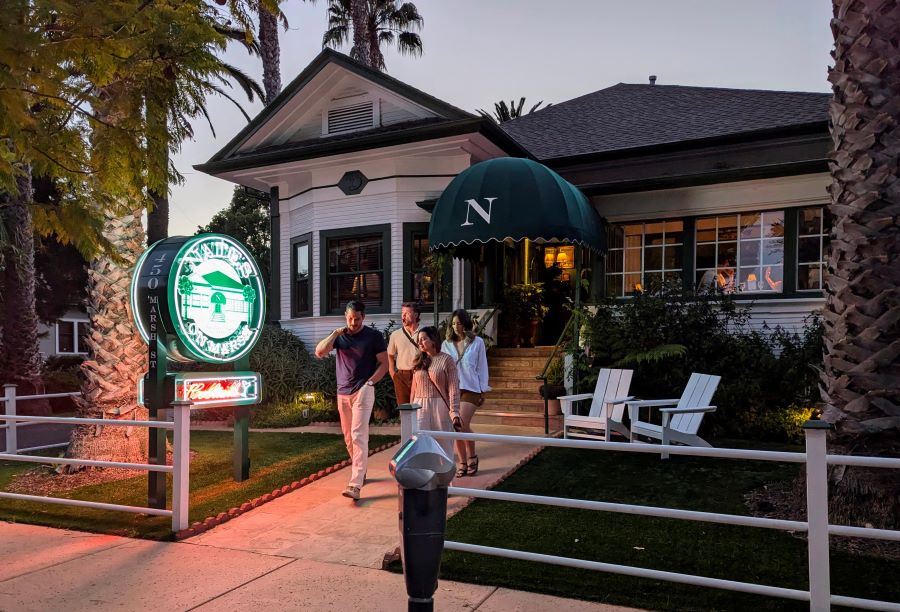
Imagine grandma’s rambling old house updated by a decorator with a great eye for color and texture, a strange thing for cowboys, and just a teensy cocaine habit. Nate’s, serving California-fresh Italian fare, received a “mention” from Michelin not long ago — short of a star, but evidence that the jurists of the world’s most significant court of foodie opinion were watching. Nate himself was at the host stand the night we came, and I asked him if that created a lot of pressure, what with every meal having to be perfect to get a star and all. “We don’t want a star!” he said. “We just want to make our guests happy!” Good for Nate, I say.
But hey, we would have given him a star that evening. The kitchen nailed the Polpo (octopus), which it gets right by braising it low and slow and then giving it a quick sear. The local lamb pappardelle ragu was richly meaty yet somehow Cali-fresh. The wine list is excellent, but I didn’t see as much Edna Valley as I expected. Lots of Paso Robles, and, as you might predict, Italy. Nate’s cocktail program includes several “secret handshake” cocktail geek favorites (Penicillin, Blood and Sand) that show the barkeeps know their craft.
Novo Restaurant
Everything was on point at this long-tenured California-meets-the-world hotspot, which uses fresh local ingredients in a menu that reaches from South America to Asia.
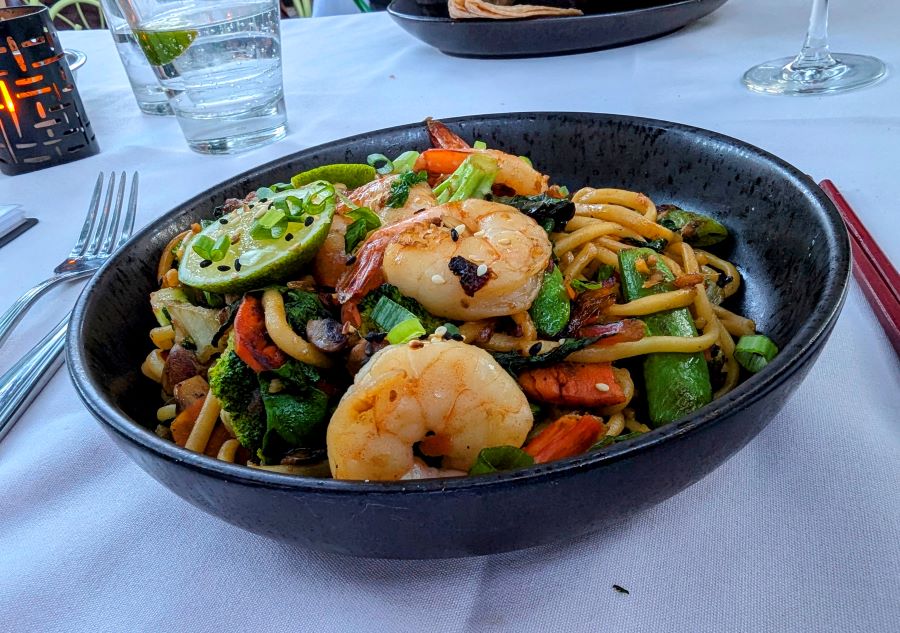
We loved the recommended Chow Novo, the chef’s take on old-school chow mein, which has been on the menu since the restaurant opened in 2003. The wine list has generous by-the-glass and half-bottle selections, including a good sampling of Edna Valley and Central Coast numbers. It’s open for lunch and “late lunch” (2 p.m. to 5 p.m.), so it’s an ideal spot for between-winery-visit meals. Ask for a dinner table outside, along San Luis Creek, where at sundown a symphony of frogs offers a lovely accompaniment to your vanilla bean creme brulee.
Eureka!
The burger-beer-and-bourbon bistro, with restaurants across California, offers all sorts of burgers. We opted for the original, and it didn’t disappoint: Too big to wrap your mouth around, well-architected, and juicy. We split it, along with the hand-cut, skin-on fries, and we both came away glassy-eyed and smiling. They also offer handhelds and salads, but the main business here is between the buns. (Though I will admit we saw a platter of pulled pork nachos move past in a server’s hand and we nearly followed her across the room.)
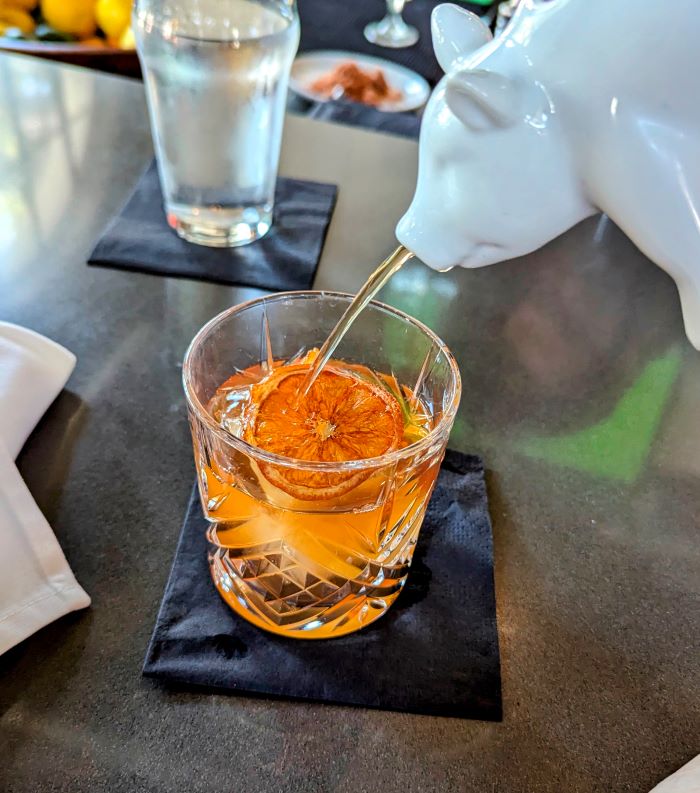
Madonna Inn
Okay, this one’s an outlier, and it’s a qualified recommendation. But if you have any taste for a high camp experience as you travel, drop by the Silver Bar Cocktail Lounge at the Madonna Hotel for an afternoon drink and snack you won’t forget. The design is Liberace-meets-’60s-Vegas-by-way-of-Wonderland, a riot of tufted pink and stained glass. It’s adjacent to the Gold Rush Steak House (feeling brave? Book dinner), whose round booths look like red leatherette tilt-a-whirl cars with gilded rims, beneath a ceiling mad with floral arrangements and studded with candelabra-style chandeliers.

The bar is accented by a wooden arbor hand-carved by an Italian craftsman brought over specifically for the effort; when he died, the project was finished in trompe l’oeil. For some reason, these places are sometimes written up straight-faced in guidebooks and travel articles — as is the hotel itself, which offers 110 of individually designed rooms, some with Catskills-honeymoon-style themes and details (rock wall showers; the hallucinogenic Madonna Suite). After we went I heard that the men’s bathroom is not to be missed. Sadly, I did. (Note that the Copper Inn Cafe lacks the comical exuberance of the adjacent bar and restaurant.)
Wine Bars in San Luis Obispo
- Region. You may be familiar with this high-concept style of wine bar, where you use a card to automatically access pours of wines kept under glass and gas. Here they are organized by, wait for it…region, and the SLO cluster includes a few Edna Valley bottles, some from nearby AVAs, and a whole lot from Paso Robles. Over 100 wines are on offer, all from small makers.
- Saints Barrel. Wine tasting bar with charcuterie and mezze, offering local, national, and international pours.
Other Things To Do in SLO
You could spend your entire trip visiting wineries, but as you’ve probably learned, you shouldn’t. There are a few museums, historical attractions, arts facilities, one-off shops, and more of the kinds of features any well-endowed small town seeking to attract visitors offers. Cal Poly often has musical and theater performances that enliven things. For ideas and details, SLO has an excellent visitor website.
Here are just a few ideas to note:
Terrace Hill Open Space
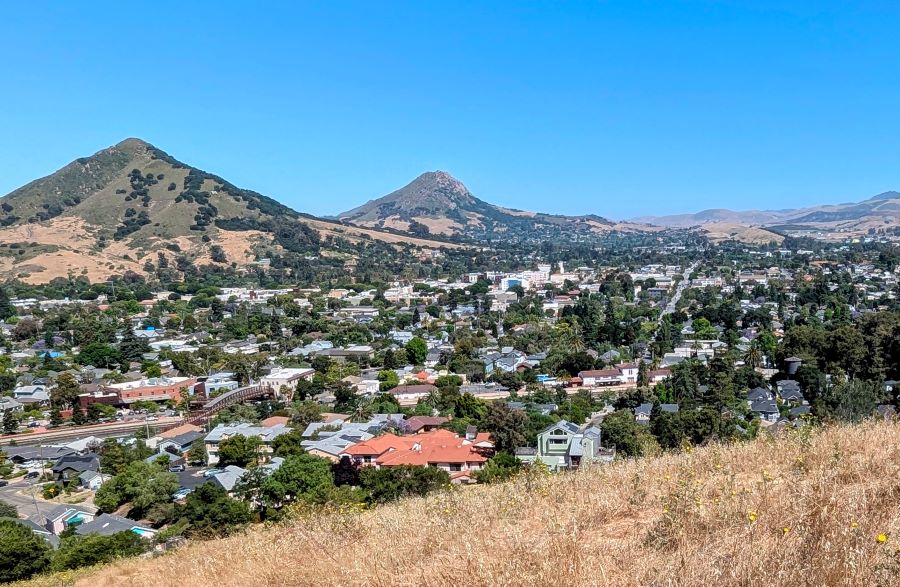
This .8-mile trail is no big climb — it’s open and plainly marked — but it takes you to the top of one of the many minor volcanic stubs that ring SLO. From there you get a 360-degree, raptor’s-eye view of the entire region: SLO, Cal Poly, the train tracks bisecting the town, the mountain gaps that the Pacific breezes slip through, any number of the Nine Sisters, close-in wine country…the whole area you’ve come to visit. It’s a great way to spend a morning before a full day of touring. Just set your GPS to Terrace Hill Open Space and your car will take you to the residential neighborhood where you’ll find the trailhead, which looks like a narrow driveway.
Mission San Luis de Tolosa
If you’re a California mission completist, amateur historian of colonialism, or just someone who likes a dose of history wherever you go, it’s worth ducking into this handsome adobe building, located just on the fringe of downtown. Though established on this site in 1772, it has been wrecked, rebuilt, and renovated so many times it looks little like the original (the bell tower is New England style, for instance). The origin story includes an alarming amount of bear meat. Daily tours start at 1:15 p.m.
Morro Bay
Notable for its massive volcanic protuberance just offshore, this beach area and estuary, just 20 minutes from SLO, is worth a day by itself. Biking, hiking, shelling, boating, paddleboarding, kayaking, swimming, surfing, birding (Peregrine falcons!)…it’s all there.
Avila Beach
I mention this small beach community because it’s the alternative to the bigger, more commercialized Pismo Beach. Avila Beach, with more modest amenities but significant charms, is popular with locals. Plus, it’s only 15 minutes from the heart of downtown SLO. Expect a small boardwalk, a pier, a beach good for strolling, and the usual concessions. There are a few nicer restaurants and wine bars, but don’t expect anything fancy.
Bubblegum Alley

It’s repulsive, it’s hilarious, and you just have to leave your dignity in your glove compartment and go. Buy some gum at the CVS, chew it up, head to this alley on the 700 block of Higuera Street downtown, and press your contribution onto the wall, where it will join tens of thousands of other globs of gum that “decorate” the walls. Started by a Cal Poly dental professor who wanted to encourage his students to dispose of their chewing gum…no, actually, I just made that up. Nobody’s quite sure how the tradition of people coming to this alley and sticking chewing gum to the walls started, but it’s a true only-in-SLO experience. Do it. Take a picture. Tell a story when you get home. Then go have a glass of wine at Region, just a couple of blocks away, to drink it off.
